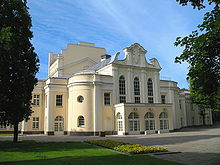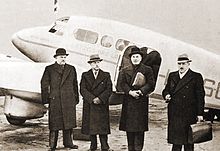Main article: Temporary capital of Lithuania
After Vilnius was occupied by the Russian Bolsheviks in 1919, the government of the Republic of Lithuania established its main base here. Later, when the capital of Vilnius was annexed byPoland, Kaunas became the temporary capital of Lithuania,[19] a position it held until 28 October 1939, when the Red Army handed Vilnius to Lithuania.[20] The Constituent Assembly of Lithuaniafirst met in Kaunas on 15 May 1920. It passed some important laws, particularly on land reform, on the national currency, and adopted a new constitution. The military coup d'état took place in Kaunas on 17 December 1926. It was largely organized by the military and resulted in the replacement of the democratically elected government with a conservative authoritarian government led by Antanas Smetona.[21] The last meeting of the Lithuanian government was held just before midnight in Kaunas on 14 June 1940. During it, the ultimatum presented by the Soviet Union, was debated.
Between the World Wars industry prospered in Kaunas; it was then the largest city in Lithuania. Under direction of the mayor Jonas Vileišis (1921–1931) Kaunas grew rapidly and was extensively modernised. A water and waste water system, costing more than 15 million Lithuanian litas, was put in place, the city expanded from 18 to 40 square kilometres (6.9 to 15.4 sq mi), more than 2,500 buildings were built, plus three modern bridges over the Neris and Nemunas rivers. All the city's streets were paved, horse-drawn transportation was replaced with modern bus lines, new suburbs were planned and built (Žaliakalnis neighbourhood in particular), and new parks and squares were established.[14] The foundations for a social security system were laid, three new schools were built, and new public libraries, including the Vincas Kudirka library, were established. J. Vileišis maintained many contacts in other European cities, and as a result Kaunas was an active participant in European urban life.[22]
During the inter-war period Kaunas had a Jewish population of 35,000–40,000, about one quarter of the city's total population.[23] Jews made up much of the city's commercial, artisan, and professional sectors. Kaunas was a centre of Jewish learning, and the yeshiva in Slobodka(Vilijampolė) was one of Europe's most prestigious institutes of higher Jewish learning. Kaunas had a rich and varied Jewish culture. There were almost 100 Jewish organizations, 40 synagogues, many Yiddish schools, 4 Hebrew high schools, a Jewish hospital, and scores of Jewish-owned businesses.[citation needed] It was also an important Zionist centre.[24]
Soviet occupation[edit]
In June 1940, the Soviet Union occupied and annexed Lithuania in accordance with the Molotov–Ribbentrop Pact.[25][26]
Nazi occupation[edit]
After the outbreak of German invasion into USSR on 22 June 1941, the June Uprising against the retreating Red Army began in Kaunas and a short-lived period of independencewas proclaimed in Kaunas on 23 June 1941.[27] During the battles with the Red Army, Lithuanian rebels secured government offices, police stations, shops, warehouses, and attempted to re-establish order in the city. On 25 June the main German forces marched into the city without opposition and almost in parade fashion. The Nazi Germans did not recognize the new provisional government, but they did not take any actions to dissolve it until the establishment of a German civil administration on 17 July. The government's powers were taken over by the new occupants.[28] Nazi Germany established the Reichskommissariat Ostland in the Baltic States and much of Belarus, and the administrative centre for Lithuania (Generalbezirk Litauen) was in Kaunas ruled by Generalkommissar Adrian von Renteln.[29]
Jewish community of Kaunas[edit]
Main article: Kovno Ghetto
Jews began settling in Kaunas in the second half of the 17th century. They were not allowed to live in the city, so most of them stayed in the Vilijampolė settlement on the right bank of the Neris river. Jewish life in Kaunas was first disrupted when the Soviet Union occupied Lithuania in June 1940. The occupation was accompanied by arrests, confiscations, and the elimination of all free institutions. Jewish community organizations disappeared almost overnight. Soviet authorities confiscated the property of many Jews, while hundreds were exiled to Siberia. Meanwhile, theLithuanian Activist Front, founded by Lithuanian nationalist émigrés in Berlin, disseminated anti-semitic literature in Lithuania.[23]
Following Hitler's invasion of the Soviet Union on 22 June 1941, Soviet forces fled from Kaunas. Both before and after the German occupation on 25 June, the anti-Communists began to attack Jews, blaming them for the Soviet repressions, especially along Jurbarko and Kriščiukaičio streets.[23] The Lithuanian provisional government established a concentration camp at the Seventh Fortress, one of the city's ten historic forts, and 4,000 Jews were rounded up and murdered there. Prior to the construction of a museum on the site, archaeologists unearthed a mass grave and personal belongings of the Jewish victims.[30] At times Lithuanian Jews were murdered in their homes with unprecedented brutality - slowly sawing off heads or sawing people in two. The Ninth Fortress has been renovated into a memorial for the wars and is the site where nearly 50,000 Lithuanians were killed during Nazi occupation. Of these deaths, over 30,000 were Jews.[31]
Soviet administration[edit]
Beginning in 1944, the Red Army began offensives that eventually reoccupied all three of the Baltic states. Kaunas again became the major centre of resistance against the Soviet regime. From the very start of the Lithuanian partisans war, the most important partisan districts were based around Kaunas.[9] Although guerrilla warfare ended at the time of 1953, Lithuanian opposition to Soviet rule did not. In 1956 people in the Kaunas region supported the uprising in Hungary by rioting.[32]On All Souls' Day in 1956, the first public anti-Soviet protest rally took place in Kaunas: citizens burned candles in the Kaunas military cemetery and sang national songs, resulting in clashes with the Militsiya.[9]
On 14 May 1972, 19-year-old Romas Kalanta, having exclaimed "Freedom for Lithuania!", immolated himself in the garden of the Musical Theatre, after making a speech denouncing the Soviet suppression of national and religious rights.[33] The event broke into a politically charged riot, which was forcibly dispersed by the KGB and Militsiya. It led to new forms of resistance:passive resistance all around Lithuania. The continuous oppression of the Catholic Church and its resistance caused the appearance of The Chronicle of the Catholic Church in Lithuania. In strict conspiracy, Catholic priest Sigitas Tamkevičius (now the Archbishop Metropolitan of Kaunas) implemented this idea and its first issue was published in the Alytus district on 19 March 1972. The Kronika started a new phase of resistance in the life of Lithuania's Catholic Church and of all Lithuania fighting against the occupation by making known to the world the violation of the human rights and freedoms in Lithuania for almost two decades.[34] On 1 November 1987, a non-sanctioned rally took place near the Kaunas Cathedral Basilica, where people gathered to mark famous Lithuanian poet Maironis' 125th birthday anniversary. On 10 June 1988, the initiating group of the Kaunas movement of Sąjūdiswas formed. On 9 October 1988, the Flag of Lithuania was raised above the tower of the Military Museum.[9] Kaunas, along with Vilnius, became the scene of nearly constant demonstrations as the Lithuanians, embarked on a process of self-discovery. The bodies of Lithuanians who died in Siberian exile were brought back to their homeland for reburial, and the anniversaries of deportations as well as the important dates in Lithuanian history began to be noted with speeches and demonstrations. On 16 February 1989 Cardinal Vincentas Sladkevičius, for the first time, called for the independence of Lithuania in his sermon at the Kaunas Cathedral. After the services, 200,000 persons gathered in the centre of Kaunas to participate in the dedication of a new monument to freedom to replace the monument that had been torn down by the Soviet authorities after World War II.[35]
Restored independence[edit]
After World War II Kaunas became the main industrial city of Lithuania – it produced about a quarter of Lithuania's industrial output.
After the proclamation of Lithuanian independence in 1990, Soviet attempts to suppress the rebellion focused on the Sitkūnai Radio Station.[36] They were defended by the citizenry of Kaunas.[37] Pope John Paul II made the Holy Mass for the faithful of the Archdiocese of Kaunas at the Kaunas Cathedral Basilica and held the meeting with the young people of Lithuania at S. Darius and S. Girėnas Stadium, during his visit to Lithuania in 1993.[38] Kaunas natives Vytautas Landsbergis and Valdas Adamkus became the Head of state in 1990, and, respectively, in 1998 and 2004. Since the restoration of independence, improving substantially air and land transport links with Western Europe have made Kaunas easily accessible to foreign tourists. Kaunas is famous for its legendary basketball clubŽalgiris, which was founded in 1944 and was one of the most popular nonviolent resistance ways during its struggle with the CSKA Moscow. In 2011, the largest indoor arena in the Baltic States was built and was named Žalgiris Arena. Kaunas hosted finals of the widely appreciated EuroBasket 2011.















No comments:
Post a Comment